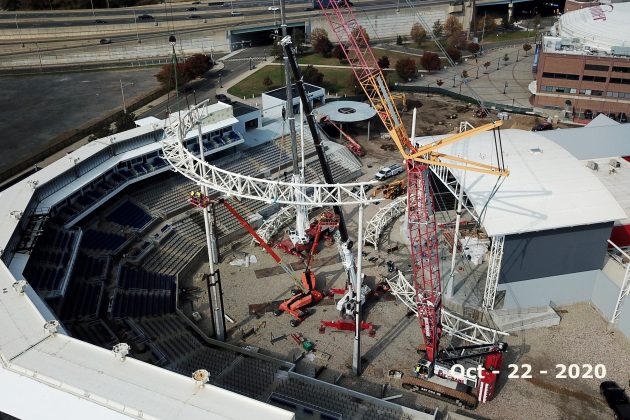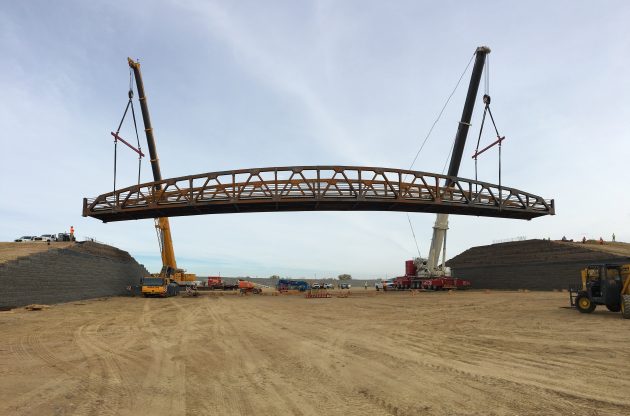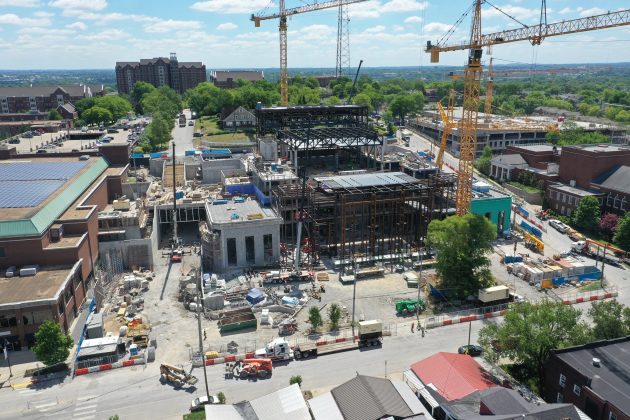
News
Cranes
Projects & Infrastructure
Project of the Year recipients use cranes to get the job done
May 25, 2021 By Crane & Hoist Canada Staff
The annual Project of the Year awards by the Steel Erectors Association of America (SEAA) has recognized seven steel erection companies for their deliveries of unique structural steel construction projects, as well as for the work, collaboration, and logistics that went into each project.
Each winner was selected from one of four categories, which were based on the dollar amount of the erection contract; additionally, three companies received Honourable Mention. Categories are Class I up to $500,000; Class II $500,000 to $1 million; Class III $1 million to $2.5 million; and Class IV over $2.5 million. Recipients were selected by an independent panel of judges, and were notified in April 2021 for projects that were completed in 2019 or 2020.
“Erectors often work in close collaboration with other teams and trades, and sometimes the customer. Challenges frequently deal with logistics, crane selection and rigging methods, and execution of complicated connection plans,” said Alan Sears, SEAA Awards committee chairman. “We congratulate these companies for excellent delivery of these unique structural steel construction projects.”
2021 Project of the Year winners
Hodges Erectors Inc., for Turnberry Ocean Club condo entrance, Sunny Isles, Florida
(Class I for erection contracts up to $500,000)
This oceanfront condominium tower starts with a grand entrance composed of a free spanning structure. The frame of plate girder and tube steel spans 150 feet from the building façade to a water fall feature. As the curved beams are under compression at both ends, the structure was built without intermediate support columns. One of the main challenges was the number of mobilizations required due to sequencing. Hodges Erectors used a tower crane for unloading and erection for about half of the project, but had to bring in a 450-tonne mobile crane, properly shored, to set up on a parking garage to complete the job.
FM Steel LLC, for Talking Stick Resort arena renovations, Phoenix, Arizona
(Class II for $500,000 to $1 million)
This job is part of the redevelopment to convert a small, dated arena into a new venue for basketball teams. The steel structure will hold a new center-hung scoreboard that is six times larger than the previous videoboard, and two new LED ribbon boards. This project required multiple mobilizations in order to work around home games. In addition, limited headroom for the crane meant that some steel was transferred in mid-air from the crane using bull rigging techniques.
United Steel Inc., for Hartford Healthcare Amphitheater, Bridgeport, Connecticut
(Class III for $1 million to $2.5 million)
This redevelopment project was a conversion of a dilapidated ballpark into an amphitheater. The hallmark of the building is a 125-foot high tensile roof and a unique 107-foot high pavilion entrance, which is complemented by a 25 ft oculus. This structure required extensive planning and coordination utilizing three cranes working in unison on a tight site to install a 135-foot diameter trussed ring that supports a 60,000 lb. cable-supported center mast and several cable-supported ‘flying masts’.

United Steel Inc., utilizes three cranes for Hartford Healthcare Amphitheater. Courtesy of Steel Erectors Association of America (SEAA).
Deem Structural Service for Buddy Holly Hall performing arts centre, Lubbock, Texas
(Class IV for over $2.5 million)
This 220,000 square-foot music venue features a 13-tonne, funnel cloud-shaped staircase, and a guitar wall consisting of more than 9,000 pieces of cast aluminum guitar picks depicting Buddy Holly. Complicated sequencing, limited site space, monitoring major truss deflections, and bracing were among the challenges of the job. In addition, connection design was delegated to the steel team. The building of the funnel cloud-shaped stair comprised of double-axis hollow structural section (HSS) tubing, supported only by cantilevered steel at each floor level.
Three companies received Honourable Mention
High Plains Steel Services LLC, for Hunters Overlook Bridge, Windsor, Colorado (Class I)
A 168-foot clear span bridge over a private reservoir was purchased from a bridge supplier, but the construction method proposed by the supplier was drastically over budget. High Plains Steel was brought into the project, and worked with the customer’s crane supplier to devise an alternative construction method that saved tens of thousands in costs.

High Plains Steel works with customer’s crane supplier to reduce project costs. Courtesy of the Steel Erectors Association of America (SEAA).
CAS Steel Erectors Inc., for International African American Museum, Charleston, South Carolina (Class III)
South Carolina is a multi-hazard zone subject to hurricanes, earthquakes, and flooding, causing unique construction challenges. The new museum, a 41,760 square-foot elevated structure, required numerous moment and seismic welds and use of an unprecedent zero tolerance brick relief system. CAS Steel Erectors built a temporary canopy with cantilevered beams and scaffolding to temporarily shore the cantilevered beams at elevation until moment welds were completed.
Cooper Steel for Belmont University Performing Arts Center, Nashville, Tennessee (Class IV)
A multi-purpose theater, this structure features a dome ceiling and arch entryways. Cooper Steel served as both the fabricator and erector on the project. In all, 14 trusses were erected. They weighed up to 21.5 tons and measured 91 ft. With minimal laydown area available, the trusses were erected directly off the trailer and delivery times had to be carefully coordinated. To speed up the process, Cooper Steel pre-fabricated large pieces of steel off site. In addition, the dome—consisting of 400 individual pieces with an accuracy tolerance half an inch—required specific angles, sizing, and erection sequences.

Cooper Steel served as both the fabricator and erector on Belmont University Performing Arts Center project. Courtesy of the Steel Erectors Association of America (SEAA).
Print this page